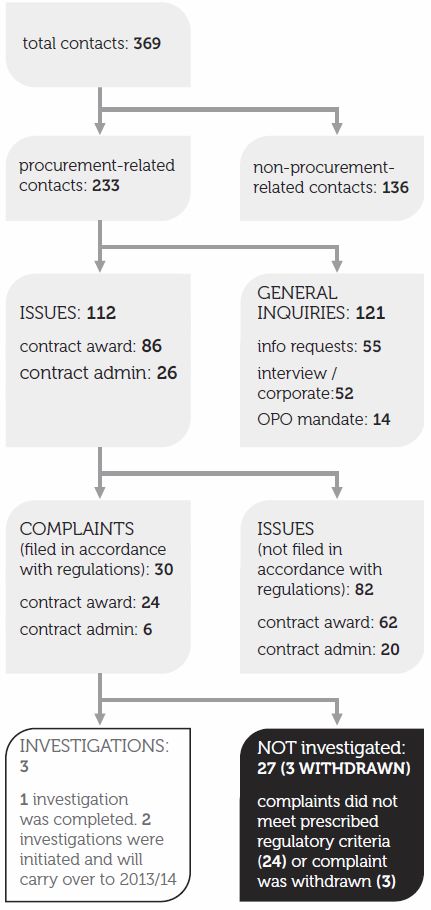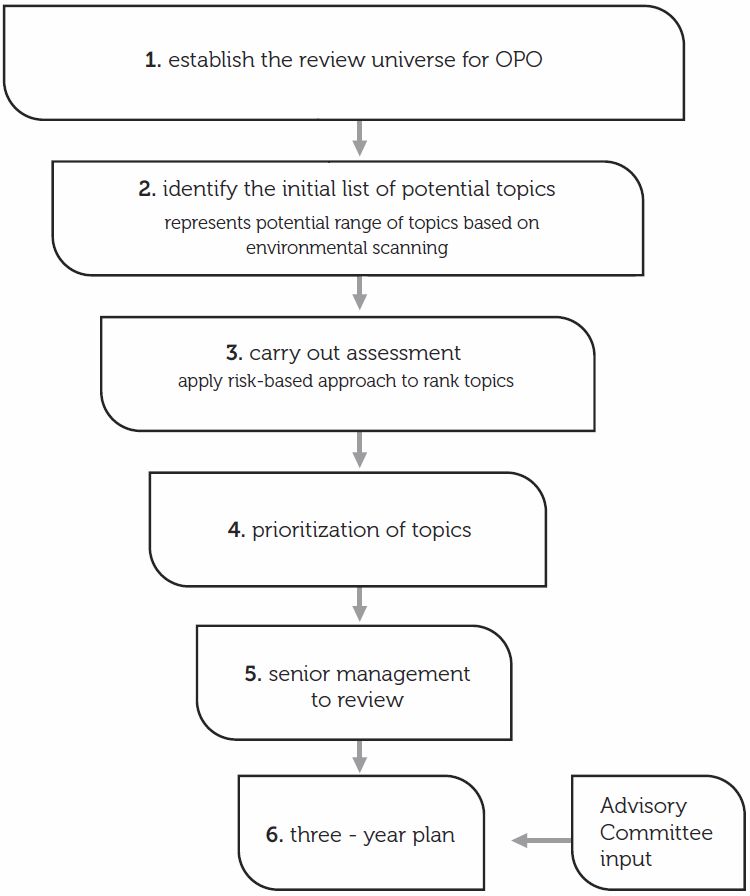Investigate
Reviewing Supplier Complaints
When suppliers bring issues to our attention, our goal is to address their concerns as expeditiously as possible. In most instances, we address the issue through our education and facilitation roles. However, there are situations where neither is sufficient or suitable to resolving the issue. In instances when facilitation has proven unsuccessful and the supplier chooses to pursue the matter further, their complaint must be filed in accordance with the Procurement Ombudsman Regulations.
Any complaint filed in accordance with the Regulations is then assessed to ensure it meets the prescribed regulatory criteria (see Diagram 6). The Regulations direct that any complaint which meets the prescribed regulatory criteria is to be reviewed (i.e. investigated).
This past year, 30 complaints were filed in accordance with the Procurement Ombudsman Regulations. Of the 30, 27 were either withdrawn (e.g. issue resolved within the 10 days through facilitation), or did not meet the regulatory criteria and could not be reviewed (e.g. contract value exceeded Office of the Procurement Ombudsman (OPO) dollar thresholds, complaint directed at an agency or Crown Corporation outside of the Office's jurisdiction).
In cases where the regulatory criteria are not met, we will, at a minimum, bring the issue to the attention of the Deputy Head of the department or agency. As a precautionary measure, we have also begun to subject all written complaints to an expanded assessment to determine if they include any supplementary issues (i.e. in addition to those identified by the supplier.) In instances where a complaint does not meet the regulatory criteria for review, OPO may still identify issues which warrant further action.
For any complaint that meets the prescribed regulatory criteria and is reviewed, the Ombudsman is required to provide findings and recommendations within 120 days of the filing of the complaint.

This past year, three complaints met the requirements prescribed by the Regulations. Of these three, one investigation was completed and an additional two were initiated and will carry over to 2013-2014. A summary of the investigation completed in 2012-2013 follows:
Investigation Summary
Supplier's Bid Wrongfully Deemed Non- Compliant on the Basis of Undisclosed Evaluation Criteria
A supplier filed a complaint claiming:
- the solicitation documents did not provide the required breakdown of the allocation of points;
- the evaluation criteria did not specify the required minimum score;
- the department launched another round of solicitations without considering the supplier's bid; and
- the supplier was denied a request for a formal debriefing following the award of the contract.
Among the remedies requested by the supplier was compensation.
Under section 13(1) of the Procurement Ombudsman Regulations, the Ombudsman can recommend the award of compensation if certain conditions are met. In making such a recommendation, the Procurement Ombudsman is required to consider several factors, including whether the complainant submitted a bid or was prevented from doing so; the likelihood that the complainant would have been awarded the contract if it were not for the actions of the department; and the degree to which the complainant was prejudiced.
The review found evidence to support all four allegations. In turn, the department acknowledged that the procurement process had been faulty. Based on the Procurement Ombudsman Regulations, however, the Procurement Ombudsman could not recommend compensation. Specifically, it was determined that if the supplier's bid had been evaluated against the evaluation criteria as presented in the solicitation documents, the bid would have fallen short. It was also concluded that all bidders were treated equally and that the complainant was provided the same opportunity as the other bidders.
Things To Make You Scratch Your Head…
When did submitting proposals become a race?
A contracting process resulted in two suppliers submitting the same person to do the work. The department informed one of the two suppliers that this was not acceptable and that the supplier's bid had been rejected because the other bid was submitted first.
Diagram6
For OPO to review a complaint regarding contract award, it must meet the following regulatory criteria:
- Complaint is a Canadian supplier.
- Complaint is filed in writing, within prescribed timeframes.
- Contract has been awarded.
- Contract value is less than $25K for goods or less than $100K for services.
- Department falls under the jurisdiction of the Ombudsman.
- Application of Agreement on Internal Trade, except for dollar thresholds.
- Facts or grounds of the complaint are not before the Canadian International Trade Tribunal or the courts.
- Reasonable grounds to believe that the contact was not awarded in accordance with regulations made under the Financial Administration Act.
Complaints on the administration of contracts must meet some of the above criteria (however, no dollar thresholds apply). Additional regulatory criteria include:
- Supplier must have been awarded the contract to which the complaint relates.
- Complaint cannot be about the application/interpretation of the terms and conditions (in these cases, Alternative Dispute Resolution (ADR) services are available.)
For the complete list of criteria, please consult the Procurement Ombudsman Regulations.
Reviewing Government Procurement Practices
Another element of our Investigate pillar is the review of the procurement practices of departments for acquiring materiel and services. These reviews are intended to examine systemic issues to assess the fairness, openness and transparency of procurement practices and make recommendations to the relevant department for improvement. We determine our practice review topics in two ways:
- through the development of a three-year review plan and
- through consideration of the issues raised by stakeholders.
-
Three-year plan
OPO updated the way procurement practice review topics are selected. The update included enhancing our ability to monitor for potential procurement issues, updating our topic-selection criteria, developing a draft three-year plan, and researching the feasibility of establishing an external advisory committee to provide independent feedback on that plan.
Diagram 7 highlights the six key phases of the updated methodology used for the selection of procurement practice review topics.

The starting point for the practice review topic selection process was to establish the review universe. The review universe represents all potential areas of review activities. The review universe was based on an assessment of the procurement areas where inherent risks may exist. A scanning exercise was then conducted to gather and analyze available information on the procurement areas contained within the review universe. This scanning process included, but was not limited to, analyzing the following:
- Supplier complaints received by the Office;
- Issues identified by suppliers, federal officials, professional organizations, and parliamentarians through OPO outreach activities; and
- Information gleaned from publications on national and international procurement issues, trends and developments.
An initial list of potential topics was derived from this scanning process.
The list of initial topics was assessed by a multi- disciplinary team of procurement, communications, and quality and risk management specialists in OPO. Risk-based assessment criteria were applied to each topic. During this time, OPO also consulted with other oversight bodies to minimize overlap and workload implications to departments, as well as with the largest procuring departments to obtain their views on potential risks to the procurement system.
This process has lead to the development of a three-year plan of procurement practice review topics which will be reviewed by the external advisory committee and then implemented over the next three years.
-
Issues Raised by Stakeholders
Section 4 of our Regulations allows the Procurement Ombudsman to "review the practices of a department for acquiring materiel and services…if there are reasonable grounds to do so…" There are typically two ways that enable the Ombudsman to establish the required “reasonable grounds” to launch a review:
- From concerned individuals raising potential issues regarding a particular procurement process or a series of specific contracts. We analyze information made available to us to determine if there is any basis for the issues.
- We subject every written complaint to a comprehensive assessment to determine whether there are supplementary issues to be examined in addition to those identified by the supplier. These expanded assessments are used to determine whether there are risks or issues that may be systemic in nature within a department or the procurement process.
The focus of the expanded assessment is to explore every option available to the Office to address potential issues. While the expanded assessment is intended to determine whether there are reasonable grounds to launch a practice review, it can also lead to other actions including:
- conducting a study or an analysis; or
- advising the department of the nature of the issues for appropriate action.
Last year, two cases were brought to the Ombudsman's attention by stakeholders where the required "reasonable grounds" was established and reviews were launched:
Procurement Practice Review Summaries
Acquisition of Training Services by a Department
The Office received allegations and supporting information alleging favouritism in the award of contracts. The complaint identified a number of contracts for specific subject-matter training issued on a non-competitive (i.e. sole source) basis to the same supplier over a two-year period.
A review was initiated to determine whether the procurement processes to acquire these services were fair, open and transparent. The Office completed an analysis of the procurement files while taking into consideration the federal legislative, regulatory and policy framework relevant to the 12 contracts in question.
The review determined the concerns raised by the stakeholder to be founded and identified systemic issues within the procurement practices used by the department to acquire training services.
The department was given an opportunity to comment on the findings of the report. In its response, the department stated that a management action plan had been developed and measures taken to address the issues identified in the report.
Acquisition of Temporary Help Services by a Department
OPO received allegations and supporting information alleging a department had shown favouritism in awarding repetitive contracts to particular consultants. A review was initiated to assess whether the department's activities supported fairness, openness and transparency and adhered to applicable policies.
The Office concluded the department did not always follow its own contracting policies and guidelines or those of the Treasury Board.
The Office recommended the department review, update as required and fully implement the organization's procurement policies and associated governance framework to ensure the Treasury Board Contracting Policy and related requirements are being met.
The department informed OPO that it has taken a number of measures to address the concerns highlighted in the review.
Follow-Up Review
Annual follow-up reviews are conducted to determine what action federal departments and agencies have taken in response to recommendations contained in our previous practice reviews. Follow-up reviews provide an opportunity to share information on improvements being implemented in response to OPO recommendations which other departments and agencies could emulate. Information on these improvements also provides the Office with an indicator of the usefulness and relevance of its work.
Last year we assessed recommendations contained in reports on procurement practice reviews conducted in 2009-2010 involving fifteen federal departments and agencies. All 15 departments and agencies participated in the follow-up process and reported on the implementation of changes designed to improve their procurement practices.
At the time of the follow-up review, implementation of many of the departmental action plans was near completion. The report highlights specific actions being taken by the departments and agencies to improve fairness, openness and transparency in their procurement practices.
- Date modified: